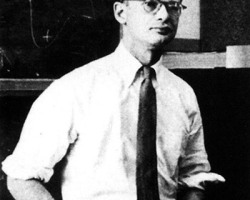Warren McCulloch, the poet-philosopher of brain science, knew a great collaborator in Walter Pitts, a high-school dropout who escaped his troubled home at 15 with a genius which would insinuate him into the inner circle of the twentieth century’s greatest minds, despite his lack of all credentials. Before Pitts deteriorated from increasingly onerous alcoholism, he and McCulloch brought mathematics to neural activity. The opening of “The Man Who Tried to Redeem the World with Logic,” Amanda Gelter’s new Nautilus piece:
Walter Pitts was used to being bullied. He’d been born into a tough family in Prohibition-era Detroit, where his father, a boiler-maker, had no trouble raising his fists to get his way. The neighborhood boys weren’t much better. One afternoon in 1935, they chased him through the streets until he ducked into the local library to hide. The library was familiar ground, where he had taught himself Greek, Latin, logic, and mathematics—better than home, where his father insisted he drop out of school and go to work. Outside, the world was messy. Inside, it all made sense.
Not wanting to risk another run-in that night, Pitts stayed hidden until the library closed for the evening. Alone, he wandered through the stacks of books until he came across Principia Mathematica, a three-volume tome written by Bertrand Russell and Alfred Whitehead between 1910 and 1913, which attempted to reduce all of mathematics to pure logic. Pitts sat down and began to read. For three days he remained in the library until he had read each volume cover to cover—nearly 2,000 pages in all—and had identified several mistakes. Deciding that Bertrand Russell himself needed to know about these, the boy drafted a letter to Russell detailing the errors. Not only did Russell write back, he was so impressed that he invited Pitts to study with him as a graduate student at Cambridge University in England. Pitts couldn’t oblige him, though—he was only 12 years old. But three years later, when he heard that Russell would be visiting the University of Chicago, the 15-year-old ran away from home and headed for Illinois. He never saw his family again.
In 1923, the year that Walter Pitts was born, a 25-year-old Warren McCulloch was also digesting the Principia. But that is where the similarities ended—McCulloch could not have come from a more different world. Born into a well-to-do East Coast family of lawyers, doctors, theologians, and engineers, McCulloch attended a private boys academy in New Jersey, then studied mathematics at Haverford College in Pennsylvania, then philosophy and psychology at Yale. In 1923 he was at Columbia, where he was studying “experimental aesthetics” and was about to earn his medical degree in neurophysiology. But McCulloch was a philosopher at heart. He wanted to know what it means to know. Freud had just published The Ego and the Id, and psychoanalysis was all the rage. McCulloch didn’t buy it—he felt certain that somehow the mysterious workings and failings of the mind were rooted in the purely mechanical firings of neurons in the brain.
Though they started at opposite ends of the socioeconomic spectrum, McCulloch and Pitts were destined to live, work, and die together. Along the way, they would create the first mechanistic theory of the mind, the first computational approach to neuroscience, the logical design of modern computers, and the pillars of artificial intelligence. But this is more than a story about a fruitful research collaboration. It is also about the bonds of friendship, the fragility of the mind, and the limits of logic’s ability to redeem a messy and imperfect world.•

